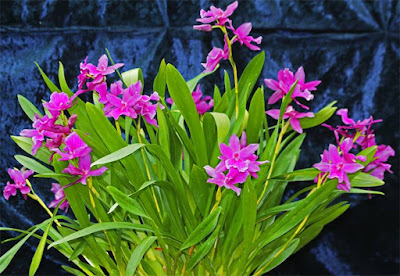Miltonia Honolulu is a hybrid whose parents are hybrid Miltonia Gayety and Miltonia Anne Warne, was made by Mr Warne and registered in 1971. This hybrid consists mainly of Miltonia spectabilis 'Moreliana' 75%, plus Miltonia flavescens 12.5% and clowesii 12.5%.
Miltonia Honolulu is a hybrid whose parents are hybrid Miltonia Gayety and Miltonia Anne Warne, was made by Mr. Warne and registered in 1971. This hybrid consists mainly of Miltonia spectabilis 'Moreliana' 75%, plus Miltonia flavescens 12.5% and clowesii 12.5%.
IDENTIFY MILTONIA HONOLULU ORCHID PLANT
It is an epiphyte plant with long, pointed, they can be up to 27 cm in length, and not more than 3 cm wide leaves. At the bottom a bulb is surrounded by 2-3 smaller leaves, they are no more than 17 cm long. The peduncle is about 16 cm long.
This orchid blooms on the beginning of autumn. On one peduncle there are 2-3 flowers. Flowers color purplish-red, about 6 cm in diameter. Sepals about 2.5 cm long and 1 cm wide, slightly arched backwards. Petals 3 cm long and 1.5 cm wide. The lip is single, wide, egg-shaped, 3.5 x 3.5 cm in size, slightly wavy along the edge, sometimes even slightly jagged.
MILTONIA HONOLULU ORCHID PLANT CARE AND CULTURE
Cultural information should only be used as a guide, and should be to be adapted to suit you. Your physical location; where you grow your plants, how much time you have to devote to their care, and many other factors, will need to be taken into account. Only then can you decide on the cultural methods that best suit you and your plants.
Light:
Miltonia Honolulu is not demanding the bright sunlight. It can be grown in bright ambient light, and in partial shade. On the windows of the southern orientation at noon and on the western after 15:00 PM, the orchid should be protected from direct sunlight: put behind a curtain or in the shade of other plants.
Temperature:
This hybrid belongs to a moderate temperature regime: The ideal temperature of the content is 16-22 ° C. For the successful cultivation at home, it is necessary that the night temperature of the content is always 5 ° C lower than the daily one.
Humidity:
This Miltonia hybrids loves relatively high humidity, so its ideal indicator is 60-80%. The higher temperature, the higher the humidity should be, and the higher the humidity, the more often and longer it is necessary to air the room where the orchids are contained, otherwise there is a high probability of rotting and kind of fungi. Too dry air has a negative effect on the growth of roots and leaves.
Substrate, growing media and repotting:
Miltonia Honolulu are mainly grow in pots. A mixture of bark of coniferous trees with peat and small pieces of a sponge is best suited as a substrate.
It is recommended to replant this type of orchid every 1-2 years, since the substrate during this period manages to lose all its beneficial properties. The best time for transplanting is the period immediately after flowering and until the moment when new sprouts reach a size of 5 cm and begin to grow their own roots. Transplantation during the hot summer period is extremely undesirable, since this may lead to a prolonged non-blooming orchid. When transplanting into a new pot, it is necessary to carefully monitor that new sprouts are not deeply buried, as they are very sensitive to decay. At the bottom of the pot should be put a thick layer of drainage.
Watering:
During the period of growth, Miltonia Honolulu needs frequent and abundant watering. Excess water during irrigation should flow freely from the pot, since stagnation of water both inside the pot and in its pan can very quickly lead to rotting of the roots and the lower part of the plant. The substrate between waterings should dry up, but in no case should not dry out completely. This is especially important during the blooming of the orchid, since re-drying is fraught with very fast drying of both flowers and buds.
In the hot summer period, daily spraying of the outer part of the plant is recommended, this has a very positive effect on the growth and development of Miltonia Honolulu. It is necessary to spray a plant only in the first half of the day, so that in the evening the water had time to dry. New sprouts of Miltonia Honolulu are quite sensitive to decay, so within two hours after spraying it is recommended to carefully wipe orchid leaves with paper napkins or handkerchiefs to remove excess water from the leaf axils.
Fertilizer:
During the period of growth, this hybrid is fertilized once every 3 weeks at 1/2 the concentration of fertilizer indicated on the package. Too concentrated fertilizer adversely affects the roots of Miltonia Honolulu, they turn black, become slimy and die.
Rest period:
Miltonia Honolulu needs a well-defined rest period to stimulate flowering. It begins immediately after the maturation of new bulbs, i.e. when new young sprouts reach the size of old ones, the fact is that orchids are much drier than usual and are not fertilized. Watering during this period should either be abandoned completely, or it should be replaced with a light spraying of the substrate. Perform this procedure should be no more than once a month.
After the appearance of peduncles, the dormant period ends and the watering of the orchid is resumed in the usual volume. After flowering, the peduncle Miltonia Honolulu is removed, if necessary, the orchid is transplanted and kept dry for some time. This is necessary to acclimatize the plant and to prevent wound rotting on the roots resulting from the transplant.















COMMENTS